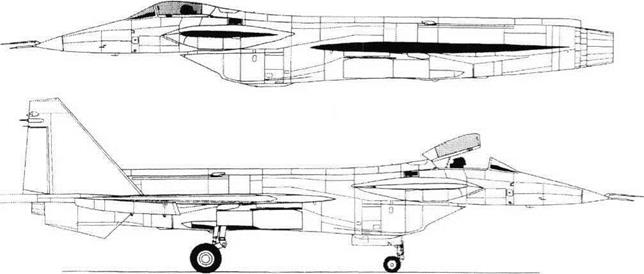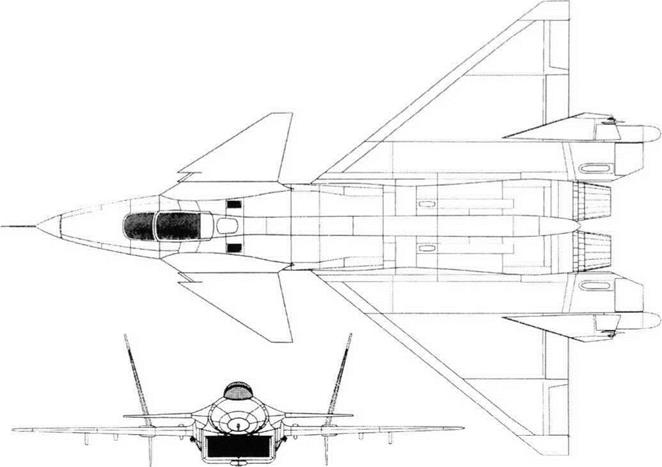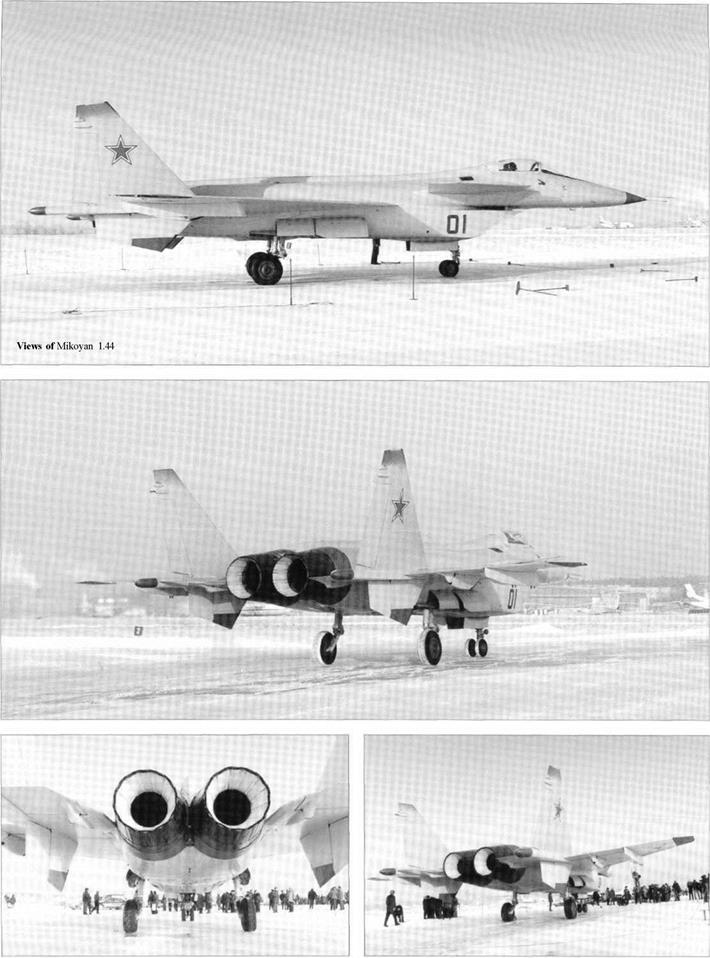MiG 1.44
Purpose: Technology test-bed to support the 1.42 multirole fighter.
Design Bureau: ANPK (Aviatsionny i Nauchno-Promishlennyi Kompleks) MiG, now the main design unit of RSK ‘MiG’.
In 1983 the large and powerful MiG OKB began general parametric study of an MFI (Mnogofunktsionahl’nyi Frontovoi Istrebitel, multirole tactical fighter). This was to be a totally new aircraft as ahead of global competition as the MiG-29 had been. It was to be larger than the MiG-29, to serve as a successor to the long-range MiG-31 and MiG-31M interceptors, but also with the supermanoeuvrability needed for close combat and the ability to fly air-to-ground missions as well. In 1986 the Council of Ministers issued a directive ordering MiG, Sukhoi and Yakovlev to make proposals for a ‘fifth-generation’ fighter to counter the threat posed by the USAF’s Advanced Tactical Fighter, which later led to the F-22A Raptor. The WS called the requirement I-90 (Istrebitel, fighter, for the 1990s). The MiG project staff eventually settled on two configurations, called Izdelye (product) 1.41 and 1.43. After prolonged discussion with the WS, features of both were combined in the 1.42. In late 1986 contracts were placed for a static-test airframe, a dynamic and fatigue-test airframe and two flight articles, as well as for the totally new AL-41F engine,
N-014 radar and various special test rigs. Supervised by General Constructor Rostislav Apollosovich Belyakov, detailed design proceeded under Chief Project Engineer Grigorii Sedov, later succeeded by Yuriy Vorotnikov. So great was the designers’ faith in the 1.42 that complete manufacturing documentation and software was completed at an early stage. Largely computerised manufacturing began at the Mikoyan experimental shop in 1989. The first flight article, designated 1.44, is a simplified technology demonstrator to prove the aerodynamics and flying qualities, performance and propulsion. Compared with the 1.42 it has an almost pure delta wing (instead of a cranked leading edge) and a slightly different air inlet system, and lacks the radar, mission avionics and internal weapons bay. By 1991 the 1.44 was structurally complete, but was awaiting flight-cleared engines, the agregat (accessory gearbox) and several other components. By this time collapse of the Soviet Union had begun to cut off funding and seriously delay the programme. The original first-flightdate of1991 -92 was forgotten, but in December 1994 the 1.44 was completed and brought by road to the OKB’s flight-test facility at the Zhukovskii NIl-WS (air force flight-test institute). On 15th December 1994 Roman Taskaev, then Chief Test Pilot, began fast taxying trials. Though several crucial elements had not been cleared for
flight it was hoped to display the aircraft ‘Blue 01’ at the MaKs 1995 show in August 1995. However, in May 1995 the hope of imminent flight trials was dashed when ANPK MiG became part of MAPO, whose sole interest was producing aircraft, such as the MiG-29 and various other types (by no means all of MiG design) to raise money. Things changed in September 1997, when Sukhoi flew the rival S-37 and Mikhail Korzhuyev was appointed ANPK MiG’s General Director. He was determined not to let this rival, and possible link to the next generation, languish in its hangar any longer. In December 1995 he got the WS to declassify photographs taken on first rollout in 1994. He then obtained permission for guests, including Defence Minister Igor Sergeyev, to walk round the 1.44 on 12th January 1999. On that occasion the aircraft rolled out under its own power (with astonishing quietness), Vladimir Gorboonov in the cockpit. At least one observer was impressed, Air Force/Air-DefenceForce C-in-CCol-GenAna – toliy Kornookov saying ‘This aircraft can do everything you want it to’. Gorboonov began the much-delayed flight-test programme on 15 February 2000, Korzhuyev saying ‘We can make the first five or six flights without external financing’.
The 1.44 is an extremely large single-seater, designed to fly significantly faster than any aircraft it might encounter. Each wing is an al
most pure cropped delta with a thickness/ chord ratio of about 3.5 per cent and leading – edge angle of about 48° (50° over the innermost section). On the leading edge are almost full-span hinged flaps, while on the trailing edge are large inboard and outboard flaperons driven by power units in underwing fairings. Unlike the MiG-29, the wing is not blended into the fuselage, nor does it have a LERX (leading-edge root extension). As far forward as possible without interfering with pilot view are enormous canard foreplanes, driven over a large angular range. Each has a sharp dogtooth, and a second smaller dogtooth due to the fact that these are 1.42 canards which do not perfectly match the large bulging fixed roots of the 1.44. Like the MiG – 29 a structural beam projects behind each wing to carry the outward-sloping upper fins, but these beams are much further apart. Thus, there is now a wide space between the beam and the adjacent engine, and in this is placed a secondary elevator, driven by a powerful actuator in a projecting fairing. Each fin has an inset rudder, and under the beams are vertical underpins with powered rudders. The basic aircraft is designed to be longitudinally unstable and to fight at alphas (angles of attack) up to at least 100°, which explains the unprecedented 16 flight-control surfaces. These are needed because, unlike the F-22 (say Mikoyan) the basic aircraft is designed for close air combat. At high alphas powerful lift is generated by the canards and by the flat nose and huge flat underside of the fuselage. Absence of LERXs means that, instead of there being an inlet under each wing, there is a single giant rectangular inlet a considerable distance below the forward fuselage. In view of the high design Mach number, the upper wall is fully variable, the sides are cut sharply back in side view, and the lower lip hinges down in high-alpha flight. The ducts diverge immediately to pass the nose gear, and then rise over the weapons bay (in this prototype occupied by instrumentation). The faces of the engines cannot be seen externally. The Saturn (Lyul’ka) AL-41F augmented turbofans are quite close together. Prototype engines were made available because, unlike the S-37, the Mikoyan aircraft is the official choice as the next-generation fighter. Dry and maximum ratings are approximately 12,000kg (26,455 Ib) and 20,000kg (44,090 Ib). This engine, said General Designer Dr Viktor Chepkin, was designed for ‘the new tactical fighters of the 1990s’. In 1993 he told co-author Gunston that the dry weight ofthe AL-41F is ‘about the same as that of the previous-generation engines with half the power’, the actual T/W (thrust:weight ratio) being 11.1 compared with 8 for the AL-31F. On the public rollout of the 1.44 the engines were astonishingly quiet. By 1997 a total of27 AL-41 and AL-4 IF engines had run, and extensive flight testing had taken place under a Tu-16 and in the left position of a MiG-25. T/W ratio of the clean aircraft is no less than about 1.33. The nozzles are circular, with petals giving a variable convergent/divergent profile, their inner faces being coated with a tan-coloured ceramic. Each nozzle can be vectored over limits of ±15° vertically and ±8° horizontally. In the nose is a forked pair of pilot tubes. The canopy swings up and back on four parallel arms. Above the huge wing the fuselage has visible waisting, and the broad but shallow central spine (which can readily be enlarged
|
|

if necessary) terminates in a capacious bay for a braking parachute. The landing gears all have levered trailing-link suspension, the single-wheel main units swinging forward into compartments beside the ‘weapons bay’ and the steerable twin-wheel nose unit retracting backwards to lie between the ducts. There is no problem with nosewheel slush entering the ducts, the height of the landing gears being dictated by landing attitude. Though Blue 01 has the full Avionika KSU-I-42 digital control system, which interlinks all the flight controls and engine nozzles, it does not have the intended Fazotron N-014 (beetle) multimode radar nor the aft-facing radar and countermeasures which in the 1.42 would occupy the two tailcones. In an armed aircraft provision would be made for a heavy load of weapons internally and on wing pylons (the 1.44 has hardpoints for six), and also for a 30mm gun. Dielectric flush antennas face in all directions, though in the 1.44 many are empty. The 1.44 lacks a RAM (radar-absorbent material) coating, but Mikoyan claim the RCS (radar cross-section) of the MFI would be ‘similar to that of the smaller F-22’.
Had the MFI progressed according to its
original schedule it could well have been, if not a world-beater, at least a formidable rival to the much slower F-22. As it is, unless ANPK MiG can find a rich foreign partner, it could gradually be overtaken by foreign competitors. In any case, the days when MiGs sold partly because of their low price are over. Several analysts consider that a production MFI would have to be priced at not less than US$100 million. Indeed, Korzhuyev has gone so far as to suggest that, instead of being one step away from a production MFI, the 1.44 must be regarded as ‘a flying laboratory to assist the development of a new fighter that will be smaller and cheaper’.
|
Dimensions (estimated) Span about Lengthabout Wing/canard area about |
15.5m 20.7m 120m2 |
50 ft 1014 in 67 ft 11 in 1,292 ft2 |
|
Weights Weight empty about |
18 tonnes |
39,683 Ib |
|
Loaded (normal) |
27 tonnes |
59,500 Ib |
|
(maximum) |
35 tonnes |
77,160 Ib |
|
Performance Maximum speed (high altitude) |
2,765 km/h |
1,718 mph (Mach 2.6) |
|
Maximum cruising speed(drythrust) |
l,800km/h |
1,1 18 mph (Mach 1.69) |
|
Range (internal fuel) not less than |
3,000 km |
1,864 miles |
|
|













